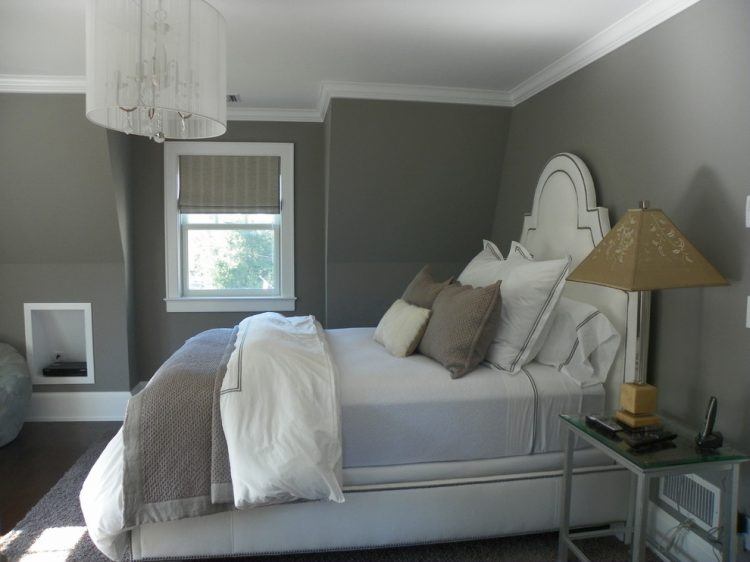Crown Molding Styles for Bedrooms

Crown molding is a decorative trim that adds a touch of elegance and sophistication to any room, including bedrooms. It can enhance the visual appeal of your bedroom by creating a sense of depth and dimension, while also highlighting the architectural features of the space.
Traditional Crown Molding Styles, Bedroom crown molding ideas
Traditional crown molding styles are characterized by their ornate designs and intricate details. They often feature a combination of curves, scrolls, and other decorative elements. These styles are well-suited for bedrooms with a classic or formal aesthetic.
- Ogee: This popular style features an S-shaped curve, creating a graceful and elegant look. It is often used in traditional and Victorian-style homes.
- Cove: A cove molding features a concave curve, adding a subtle and understated touch to the room. It is a versatile style that can be used in both traditional and modern bedrooms.
- Dentil: This style features a series of small, rectangular teeth that create a rhythmic pattern. It is often used in traditional and colonial-style homes.
Modern Crown Molding Styles
Modern crown molding styles are characterized by their clean lines and minimalist designs. They often feature simple geometric shapes and a lack of ornamentation. These styles are well-suited for bedrooms with a contemporary or minimalist aesthetic.
- Flat: A flat crown molding features a simple, rectangular profile. It is a versatile style that can be used in both modern and traditional bedrooms.
- Shadow Box: This style features a series of recessed panels that create a sense of depth and dimension. It is a popular choice for modern bedrooms.
- Geometric: Geometric crown molding styles feature simple, geometric shapes, such as squares, triangles, or circles. They are a great way to add a touch of modern flair to a bedroom.
Contemporary Crown Molding Styles
Contemporary crown molding styles are characterized by their bold designs and unique textures. They often feature unconventional shapes and materials, such as metal or wood. These styles are well-suited for bedrooms with a modern or eclectic aesthetic.
- Asymmetrical: Asymmetrical crown molding styles feature irregular shapes and curves. They are a great way to add a touch of whimsy and personality to a bedroom.
- Textured: Textured crown molding styles feature unique textures, such as wood grain or metal finishes. They are a great way to add a touch of visual interest to a bedroom.
- Color-Blocked: Color-blocked crown molding styles feature different colors or finishes. They are a great way to add a touch of personality and contrast to a bedroom.
Materials and Finishes: Bedroom Crown Molding Ideas

Choosing the right materials and finishes for your crown molding is crucial for achieving the desired aesthetic and durability. The materials determine the molding’s look, strength, and ease of installation, while the finishes impact its color, texture, and overall feel.
Wood
Wood is a classic material for crown molding, offering natural beauty, durability, and versatility. It comes in various species, each with unique characteristics.
- Hardwoods, such as oak, maple, and cherry, are strong, resistant to scratches and dents, and provide a luxurious look. They are ideal for high-traffic areas and formal spaces. However, hardwoods can be expensive.
- Softwoods, such as pine and fir, are more affordable and easier to work with. They offer a rustic charm and are suitable for casual settings. Softwoods are more prone to scratches and dents, making them less suitable for high-traffic areas.
MDF
Medium-density fiberboard (MDF) is an engineered wood product made from wood fibers. It is a cost-effective alternative to solid wood, offering a smooth, consistent surface.
- MDF is more affordable than solid wood and readily available in various profiles. It is also more stable than solid wood, making it less prone to warping and cracking.
- MDF is not as strong as solid wood and can be more susceptible to moisture damage. It is also not as easily repairable as solid wood.
Polyurethane
Polyurethane is a synthetic material that is often used for crown molding. It is lightweight, durable, and resistant to moisture and insects.
- Polyurethane is a good choice for humid environments, as it is not susceptible to warping or rotting. It is also easy to install and requires less maintenance than wood.
- Polyurethane molding can be less expensive than wood and is available in a wide range of profiles and finishes. However, it may not have the same natural beauty and warmth as wood.
Finishes
The finish you choose for your crown molding will significantly impact its look and feel.
- Paint is the most common finish for crown molding. It offers versatility, allowing you to match the molding to your walls or create a contrasting accent. Paint can be used to create a variety of effects, from sleek and modern to traditional and elegant.
- Stain enhances the natural beauty of wood by bringing out its grain and color. It creates a warm, rustic look that complements traditional and farmhouse styles. Stain is available in various colors and finishes, from light and natural to dark and rich.
- Wallpaper can be used to create a unique and decorative finish for crown molding. It offers a wide range of patterns and textures, allowing you to express your personal style. Wallpaper is particularly well-suited for accent walls and can add a touch of sophistication to any room.
Choosing the Right Material and Finish
The best material and finish for your crown molding will depend on your bedroom’s style, budget, and desired look.
- For a traditional bedroom, consider using hardwood crown molding with a stain finish. This will create a warm and inviting atmosphere. If you are on a budget, MDF with a paint finish is a good alternative.
- For a modern bedroom, consider using polyurethane crown molding with a sleek paint finish. This will create a clean and minimalist look. If you prefer a more natural look, consider using softwood with a stain finish.
- For a farmhouse bedroom, consider using reclaimed wood crown molding with a natural stain finish. This will create a rustic and charming look. If you are on a budget, MDF with a white paint finish is a good alternative.
Installation Techniques and Tips

Installing crown molding can be a rewarding DIY project that elevates the look of your bedroom. This section provides a detailed guide on how to install crown molding, including essential tools, materials, and step-by-step instructions.
Tools and Materials
Having the right tools and materials is crucial for a successful crown molding installation.
- Measuring Tape: Accurately measure the length of the walls and the crown molding pieces.
- Miter Saw: Precisely cut the crown molding at the desired angles.
- Level: Ensure that the crown molding is installed level and straight.
- Nail Gun: Securely attach the crown molding to the wall.
- Finish Nailer: Drive nails into the crown molding without damaging the wood.
- Caulk Gun: Apply caulk to fill gaps and create a seamless finish.
- Crown Molding: Choose the style and material that complements your bedroom décor.
- Wood Glue: Provide extra adhesion for a stronger bond.
- Caulk: Seal gaps and create a smooth, continuous line.
- Paintable Caulk: For a seamless finish, use paintable caulk to fill gaps and then paint over it.
- Primer: Prepare the surface for painting and enhance paint adhesion.
- Paint: Choose a paint color that complements your bedroom décor.
- Sandpaper: Smooth out any rough edges and prepare the surface for painting.
- Safety Glasses: Protect your eyes from debris and flying objects.
- Dust Mask: Protect your lungs from dust and sawdust.
Measuring and Cutting
Precise measurements and cuts are essential for a professional finish.
- Measure the Walls: Accurately measure the length of each wall where you will install the crown molding. Account for any windows or doors.
- Calculate Crown Molding Lengths: Divide the wall length by the standard length of crown molding pieces to determine the number of pieces needed.
- Mark Cutting Points: Use a pencil to mark the cutting points on the crown molding pieces, ensuring accurate measurements.
- Miter Cuts: Use a miter saw to make precise miter cuts at 45-degree angles to create seamless corners.
For inside corners, cut both pieces at 45 degrees, with the cuts facing each other. For outside corners, cut both pieces at 45 degrees, with the cuts facing away from each other.
Step-by-Step Installation Guide
Installing crown molding involves a series of steps that ensure a professional finish.
- Prepare the Walls: Ensure the walls are clean, smooth, and free from any debris. Use sandpaper to smooth out any imperfections.
- Install a Starting Point: Choose a starting point for the crown molding, usually at the corner of a room. Cut the first piece of crown molding to fit the wall length, leaving a slight overhang for trimming later. Secure it to the wall with nails or adhesive.
- Attach the Crown Molding: Use a nail gun or finish nailer to attach the crown molding to the wall. Position the nails at an angle to ensure a secure hold.
For a cleaner finish, use finish nails that are small enough to be easily countersunk and filled with wood putty.
- Cut and Install Corners: Make miter cuts at 45-degree angles for inside and outside corners. Carefully align and attach the crown molding pieces to create seamless corners.
- Fill Gaps: Use caulk to fill any gaps between the crown molding and the wall. Apply a thin bead of caulk and smooth it out with a damp finger or a caulk tool.
- Sand and Prime: Once the caulk has dried, use sandpaper to smooth out any rough edges and prepare the surface for painting. Apply a primer to enhance paint adhesion and create a smooth, even finish.
- Paint: Apply two coats of paint to the crown molding, allowing each coat to dry completely before applying the next. Use a brush or roller for a smooth and even finish.
For a professional look, use a paint sprayer to apply the paint.
Bedroom crown molding ideas – Bedroom crown molding can elevate the aesthetic of any space, adding a touch of elegance and sophistication. When designing a single bedroom house plan, especially one facing west, consider incorporating crown molding to enhance the overall visual appeal. For inspiration on how to best integrate crown molding into a west-facing single bedroom house plan, check out this resource which offers design and decor tips.
Remember, the right crown molding can accentuate the architectural features of your bedroom and create a harmonious flow throughout the entire house.
Bedroom crown molding ideas can elevate the style of your sanctuary, adding a touch of elegance and sophistication. For those seeking privacy and tranquility, consider incorporating a master bedroom at the back of the house, as detailed in this comprehensive guide on house plans with master bedroom at the back.
Whether your style leans towards classic or contemporary, the right crown molding can enhance the visual appeal of your retreat, complementing your overall design aesthetic.